There are three main ways today to have a 3D virtual business meeting using your browser – VenueGen, Altadyn’s 3DXplorer, and Avaya’s Web.alive. Of the three, VenueGen stands out by actively marketing its platform with ubiquitous Internet advertising.
But the company wants to be known for its ease of use and its engaging and compelling interface.
Low, low prices
VenueGen is free for meetings of three avatars or less, and just $49 a month for meetings of up to five avatars – comparable to WebEx pricing. The platform tops out at 60-avatar meetings, at $599 a month. That’s unlimited meetings, in any of 30-plus different venues, as long as they’re all hosted by one person. For corporations who will have multiple people hosting meetings, there are bulk discounts.
3DXplorer pricing also starts at $49 a month for meetings of up to 10 avatars each. Maximum meeting size is 100 avatars, at $490 a month.
Avaya’s Web.alive pricing is expected to be roughly in the same ball park. Maximum meeting size is 150 avatars.
The prices of all three environments are significantly lower than those of the other two popular enterprise platforms — Teleplace and ProtoSphere — both of which require software downloads to use. Prices for these two platforms are user-based and a typical deployment can run into the six figures.
In Second Life and OpenSim, pricing is determined by land area. Second Life regions run around $300 a month each for a 16-acre square, with a $1,000 setup fee. OpenSim regions typically cost between $10 and $100 months, though the software itself is free and can be downloaded and run locally at no cost except staff and hardware.
Each platform also has is own pricing intricacies. Web.alive and 3DXplorer charge for each new meeting space – VenueGen charges for each additional host, where hosts are users who can create and moderate meetings, but companies can have unlimited meetings, including simultaneous meetings, and unlimited numbers of total registered users.

“You only pay to host meetings, not to attend meetings,†said VenueGen CEO David Gardner told Hypergrid Business. “A customer may have a couple of hundred users and only a dozen paid accounts.â€
Another area of difference is that Web.alive and 3DXplorer meeting spaces are persistent. Once you create a meeting area, it stays up, whether or not there are people in the room. Second Life and OpenSim also have persistent environments, as do ProtoSphere and Teleplace.
VenueGen meeting spaces are not persistent. A room is only loaded up on a server when people arrive, and is shut down again when they leave. That means that users can’t rearrange the furniture and expect to see the changes still there when they return. Not that they would be able to, anyway – VenueGen does not currently offer any in-world editing capabilities. The only changes that users can currently make to meeting spaces is to pull up different Web pages or documents on the built-in display screens, unless they hire one of VenueGen’s partners to design a custom meeting space.
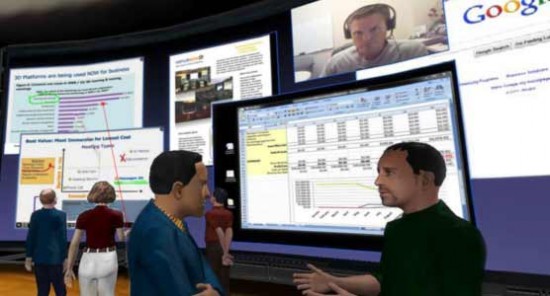
But the lack of persistence doesn’t mean that users have to sit around waiting for their virtual environments to be created.
It takes just 10 seconds to load a room, Gardner said.
The lack of persistent rooms means that VenueGen can get more use out of their servers, and allows them to offer free meetings to groups of three avatars or less.
It also allows them to offer free telephone lines – if a user has problems getting the in-world voice to work, they can simply call in to a conference call line and get the same spacial voice as if they were using a computer headset and microphone.
Rooms vs. grids
VenueGen, like 3DXplorer, Web.alive, Teleplace and ProtoSphere are all room-based – though the rooms are variously called worlds, spaces, or environments by the vendors.
By comparison, Second Life and OpenSim are grid-based. You rent land one region at a time, where the regions are laid out on a checkerboard pattern, and you can walk across from one region to another, forming one big flat world, with empty water in the spaces that are not occupied by active regions. The benefit of a grid-based architecture is that the world makes sense – we know how to navigate on a flat surface. People can wander around at will, fly, or ride vehicles across the entire world, except for areas they don’t have permission to enter.
Room-based worlds don’t allow any walking from one meeting environment to another. There is no one single map that all the environments have to be arranged on. Instead, to link multiple environments together, companies have to create teleportation portals. The downside to the room metaphor is that it’s easy to overdue it with the portals, connecting different environments together willy-nilly, so that users are unable to create a spacial map of where they are.
However, there is usually a great deal of flexiblity in the shape of the room itself. In some of the platforms, a room can be miles across, with a ceiling high up and painted to look like the sky, with smaller buildings located inside the environment. And, with careful planning, different environments can be connected to each other in such a way that it makes geometric sense and users can find their way around.
In VenueGen, for the most part, the meeting rooms are just that — single rooms, classrooms and auditoriums, though there are also some small courtyards, a space station flight deck, and a boat.
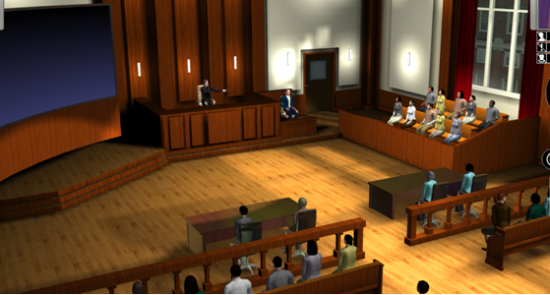
Fast on-ramp
But the big thing that sets VenueGen apart – or that they hope will set them apart – is their ease of use.
“We’ve been building this for three and a half years,†said Gardner. “We have had all kinds beta releases at different points and focus groups, offering the product for over two years to various select customers.â€
Current customers include Booze Allen Hamilton, ACS Learning (a division of Xerox), Takeda Pharmaceuticals. PricewaterhouseCoopers, and Duke University. The company has about two dozen corporate clients total, with around 3,000 total registered users.
And the user base is growing fast, he said.
“We are on-boarding 2,000 people this week at one of the companies I mentioned,†he said. “We did six demos today – it’s just exploding.â€
According to Gardner, it takes just a couple of minutes to create a room for a new meeting, and the getting started orientation for new users takes just 30 seconds.
“We really are trying to be quick, fast and inexpensive,†he said. “We are really trying to match all the lessons learned from people using WebEx.â€
So how easy it is in practice? I tried out the platform with an acquaintance who normally runs small online events with GoToMeeting. We met at McDonald’s, and fired up our laptops. It took us about 45 minutes to get into our first meeting using McDonald’s WiFi – we had to download the browser plugin, create our user accounts, select a room for our meeting, and then load the room. For me, most of the delays were in loading the room – the first few tries failed. For her, the biggest delay was that she thought she was watching the orientation video while the plugin was loading in the background – but it wasn’t. She had to go back and restart.
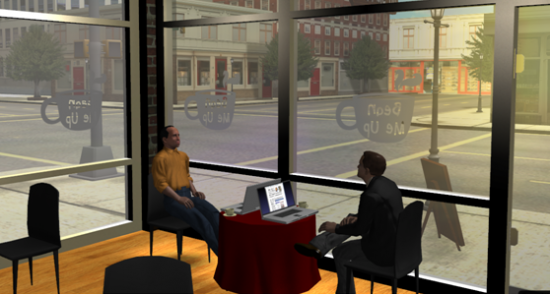
The way it works is that you install the plugin, create an account, and whoever is the host launches the meeting, sets the time, and picks a venue. Then the host invites other attendees. The guest get an email invite with a link they click that takes them right to that meeting.
When we finally got into our meeting, neither one of us could get our in-world voice to work, so we gave up and went home. Of course, we were testing this under extreme conditions – McDonald’s – and then there’s the journalist factor. Any time a journalist tries out new software, even if it runs perfectly otherwise, it immediately breaks down. It’s a law or something.
But we did get a chance to test a few of the features that make VenueGen fun to use.
For example, you can upload a photo and have your avatar automatically look like you. Okay, mine looked a little weird, but it was a bad picture.
The built-in gesturing system is also nifty. There’s a simple pop-out control box for gestures, but when you click on a gesture – say, waving your hand – the actual motion looks different each time.
“We have 50 different animations to raise that hand,†explained Gardner. “If you don’t have a large library of animations, it just looks fake.â€
Avatars also shift naturally in their seats, switching sitting positions. The idea is to make the environment feel natural and realistic.
“We’ve done a lot of usability studies and we just kept going at it until we got it right,†Gardner said.
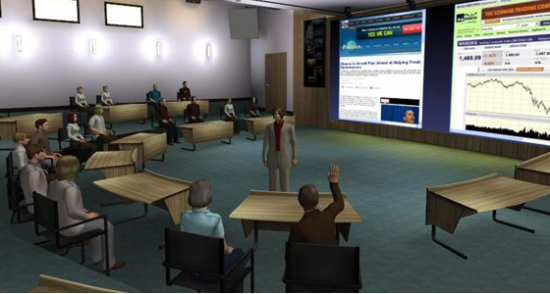
Photo-based faces help make the environment more engaging, as well.
“People want to look like themselves,†he said. “People really buy into it when they put their face on the avatar. They stop calling the avatar ‘it’ and start calling it ‘me’.â€
The avatars are also highly detailed. Although there isn’t the wide variety of clothing and accessories as in, say, Second Life, the avatars are more realistic due to higher polygon counts, he said.
According to Gardner, Second Life avatars have between 400 and 500 polygons. Teleplace and ProtoSphere have about 400. VenueGen avatars are 6,000 polygons.
“Our clothing is an actual object that moves with you, it flows with the physics engine,†he added. “And it can be worn in layers, so you can put on a shirt, a tie, and a jacket. And our clothes are not super-tight – they’re appropriate to business meetings.â€
There is no third-party marketplace for clothing and accessories, however. In fact, avatars have no personal inventories.
“It’s not a dress-up game,†Gardner said. “It’s a serious business tool.â€
The ease of use applies to setting up meeting venues, as well. There are currently a couple of dozen different meeting venues – including my favorite, the deck of a boat. New venues come out on a regular basis.
“Whenever we hear someone saying, ‘It would be great to have such-and-such venue,’ we build it,†Gardner said.
You move around the venue by hitting the up arrow – and use left and right arrows to turn. You can also right-click on any point on the floor and select “Walk to here.†You sit on a chair by right-clicking it as well. Right clicking on any screen in the venue lets you pull up a Web page, a document, or your desktop for other people to see.
When trying it out, I was able to load up a Web page but not a document or my desktop. Good think I wasn’t hosting a real meeting. I I was, the company holds free in-world training classes to help people learn to use the features. A list of public classes is here — unfortunately, without time zone information.
It’s a very stripped down environment, especially for people used to the choices available in Second Life and OpenSim. But the fact that it is so spare and lean also makes it quick to set up and use.
“If I start letting people move objects around, then it’s more than a 30-second learning curve,†Gardner said. “Right now, we have a lit of most-requested features – and that’s far down on the list.â€
So what’s at the top of the list?
“We are working on an intelligent camera that is an invisible camera that moves around the room and when someone is talking it zooms into their face,†he said. “When a slide changes, it goes to the main viewer [screen], and occasionally pans the audience.â€
The idea is to have an automatically-generated video recording that looks like it was done by a professional cameraman.
“That is our most requested feature right now,†he said.
Bandwidth savings
Virtual environments – especially those that include streaming video, PowerPoint presentations, voice connections and desktop sharing – are notorious bandwidth hogs. VenueGen tries to minimize this by pre-loading as much content as possible.
Say, for example, a company is holding a training class where they will be showing videos and presentations. The content can be added to the meeting space ahead of time.
“Then anyone who registers for that class, the content will be automatically distributed to the class prior to the meeting,†said Gardner. That frees up bandwidth for voice.
The pre-distributed content means that a typical meeting uses 80 percent less bandwidth than in WebEx, he said.
Poor man’s telepresence room
“When I started this company, I was perplexed by the question of why people pay half a million dollars for a telepresence room when WebEx is $49 a month,†said Gardner. “The answer is engagement.â€
In a recent whitepaper, VenueGen collected research about different types of meetings and ranked them by engagement.
Face-to-face meetings had the highest engagement stores, with telepresence and 3D immersive platforms tied for closed second.
Engagement is composed of a number of factors, including whether or not you feel that other people are paying attention to you, seeing where other people are looking, and the sense of being present with other people at the same time.
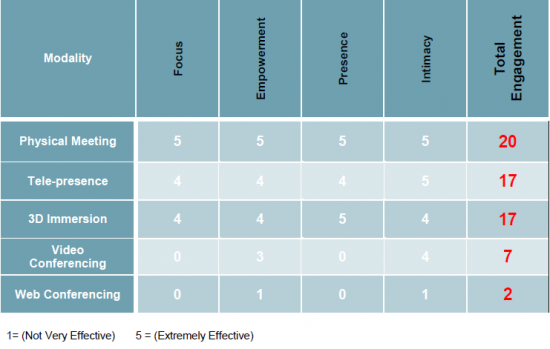
Telepresence rooms are carefully designed to allow for eye-contact, and to create the illusion of being together in the same room – neither of which is possible with most Web conferencing platforms.
Meanwhile, in terms of costs, 3D immersive meetings are dramatically cheaper than face-to-face meetings requiring travel, or building new telepresence conference rooms.
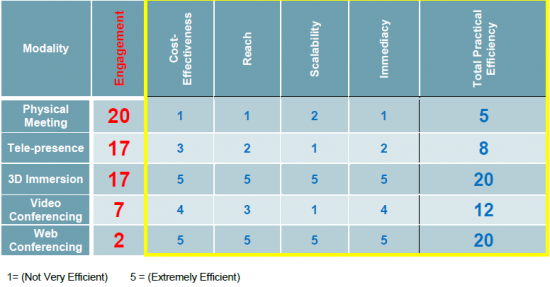
For more information, you can find the VenueGen whitepapers here.
“What if there was a way to create a telepresence room, but for the price of WebEx?†asked Gardner. “Telepresence is very expensive. It is a gift for senior executives.â€
VenueGen’s 3D alternative is risk-free, he said.
“You don’t have to buy a bunch of servers and cough up a lot of money on the front end,†he said. “We are a way to experience 3D without all the crap you have to deal with in the process. We have de-risked it.â€
Enterprise deployment
The fact that VenueGen runs in a browser makes it attractive for companies and organizations with older machines.
VenueGen also offers centralized management panels where companies can provision and de-provision accounts, and switch hosting rights from one employee to another.
There is also a tool for IT administrators to use to automatically install the plugin on corporate computers at companies where the machines are locked down for security reasons.
“Takeda just did that,†said Gardner. “They pushed it out – the same way they do all the applications when they have a locked-down desktop.â€
Corporations that need a custom environment can get one built by VenueGen or one of their partners.
“We built a hospital admitting room for one customer,†Gardner said. “They wanted it for role playing. But it’s not a core business.â€
- OSgrid back online after extended maintenance - April 16, 2025
- Analysts predict drop in headset sales this year - March 25, 2025
- OSgrid enters immediate long-term maintenance - March 5, 2025
